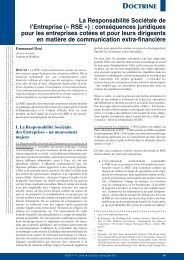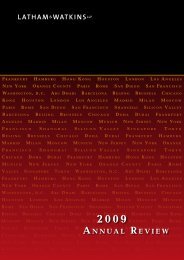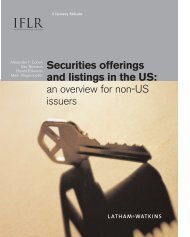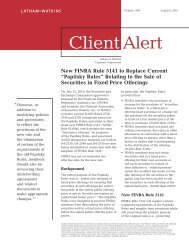A Few Important Proxy Compensation ... - Latham & Watkins
A Few Important Proxy Compensation ... - Latham & Watkins
A Few Important Proxy Compensation ... - Latham & Watkins
Create successful ePaper yourself
Turn your PDF publications into a flip-book with our unique Google optimized e-Paper software.
historically have been most involved in designing<br />
compensation programs at many companies.<br />
• The drafting process at most companies will be<br />
interactive, since questions are asked and answered,<br />
and will require multiple drafts.<br />
• Assembling the tabular disclosure on the various<br />
elements of compensation will highlight issues and<br />
plan features that probably deserve to be discussed<br />
in the CD&A, which makes it advisable to prepare<br />
draft tables early in the process (with estimated<br />
2006 numbers), rather than waiting until after the<br />
end of the year to draft the tables.<br />
We have also found that completing a checklist<br />
prior to drafting helps streamline the drafting process.<br />
SOX certification requirements generally will<br />
require CD&As to be substantially completed by<br />
the Form 10-K filing deadline. The CD&A, unlike<br />
the <strong>Compensation</strong> Committee Report, is part of the<br />
proxy and is deemed to be filed with the SEC, not<br />
merely furnished. As such, the disclosures made in the<br />
CD&A are subject to liability under Section 10(b)<br />
and are subject to the CEO and CFO certification<br />
requirements of the Sarbanes Oxley Act (SOX).<br />
CEOs and CFOs at many public companies<br />
historically have been willing to file their SOX certifications<br />
with the company’s Form 10-K, even though<br />
the compensation tables were incorporated by reference<br />
and filed in the proxy later. It is already clear that<br />
many CEOs and CFOs will not be comfortable with<br />
this approach, at least for the first CD&A, and will<br />
insist that the CD&A be drafted and approved by the<br />
<strong>Compensation</strong> Committee and by the company’s HR,<br />
legal and accounting departments before they certify<br />
and file the Form 10-K. For many calendar year companies,<br />
this means that the 2006 CD&A may need to<br />
be substantially completed by March 15, 2007, not the<br />
end of April 2007.<br />
that the standard for nondisclosure here is the same<br />
standard that applies to applications for confidential<br />
treatment with respect to registration statements and<br />
other SEC filings. It also it appears that SEC staff<br />
may be more rigorous in applying the standard to<br />
CD&As than to <strong>Compensation</strong> Committee Reports<br />
under the prior rules. Therefore, don’t assume without<br />
analysis that you won’t be required to disclose such<br />
things as actual performance targets, benchmarks and<br />
peer groups, and be prepared to justify why nondisclosure<br />
of targets would result in competitive harm to<br />
the company. Also note that if the specific targets are<br />
not disclosed, the company is required to discuss how<br />
difficult it would be for the executives or the company<br />
to achieve the undisclosed targets.<br />
Consider including additional disclosure in the<br />
<strong>Compensation</strong> Committee Report. While the new<br />
rules only require that the <strong>Compensation</strong> Committee<br />
Report state whether the <strong>Compensation</strong> Committee<br />
has reviewed and discussed the CD&A with management<br />
and whether it has recommended that it be<br />
included in the company’s annual report and proxy,<br />
<strong>Compensation</strong> Committees may wish to consider<br />
including additional disclosure in appropriate cases.<br />
An expression of the <strong>Compensation</strong> Committee’s<br />
views on the company’s compensation philosophy,<br />
plans or policies – or highlighting certain facts or issues<br />
– could help shareholders understand and shape<br />
any debate on large total compensation numbers, the<br />
relationship between compensation and company<br />
performance or unusual compensation arrangements.<br />
James D.C. Barrall is Global Chair of the Benefits and<br />
<strong>Compensation</strong> Group of <strong>Latham</strong> & <strong>Watkins</strong> LLP. For<br />
more information, go to: http://www.lw.com.<br />
Don’t assume that the specifics of performance<br />
targets need not be disclosed in the CD&A. The<br />
CD&A requires discussion of the performance factors<br />
considered in setting each element of NEO compensation.<br />
However, specific quantitative or qualitative<br />
performance targets don’t need to be disclosed if the<br />
disclosure of the targets would result in competitive<br />
harm to the company. The SEC has made it clear<br />
<br />
November 2006 | Executive <strong>Compensation</strong> Strategies







